Iris in the garden
I need some suggestions on how to use bearded irises. I have several, mixed in the perennial beds, but they seem to have somewhat unique requirements and I can't seem to put them with appropriate partners. I think I just don't grow enough plants with similar requirements.
I've done some research, but I'd love to know how folks here use them, and what they plant them with, and photos are always appreciated!
Thanks!
Dee
Comments (48)
mxk3 z5b_MI
10 years agoI grow the dwarf bearded iris - they bloom early enough in the spring to where I can really see and enjoy the blooms before surrounding plants reach full seasonal height and hide them. Hiding them isn't a bad thing during the season, as I'm not a big fan of the foliage - it's fine for a couple months but come about August gets floppy and a bit ratty-looking; but, like I said, surrounding plants/foliage divert the eye (and from some angles hide) from the unattractive foliage.
So, yea...it's the dwarf beaded for me. I've seen large stands of the regular/tall beaded iris and IMO it looks terrible as the season progresses; I suppose a few here and there are workable in the garden, but not a whole stand of them, at least not for me, due to the unattractive foliage.
I also grow Iris palladia (? sp) - now this foliage is lovely! The variegation really stands out, and it tends to look good the whole season if happy. I find if conditions are too dry for this one, they're not happy and get a bit floppy, but in soil of normal moisture they look great.
roxanna
10 years agoSome time ago, I saw a fabulous photo from Schreiner's (the iris folk!) in which they combined bearded iris with lupines. It was stunning!! I would love to try that, but am too lazy to redo any of my beds... lol
That said, I know what you mean about the iris foliage not being particularly stellar by this time of year. I have most of my beardeds at one end of a perennial border, mostly on their own, but some asiatic lilies, mums and columbine nearby. And another less salubrious area mixed in with daylilies and hosta. Gorgeous in bloom but I try to ignore the iris the rest of the year. =)
Related Professionals
Cottonwood Landscape Architects & Landscape Designers · Horsham Landscape Architects & Landscape Designers · Maple Heights Landscape Architects & Landscape Designers · Allentown Landscape Contractors · Beachwood Landscape Contractors · Cliffside Park Landscape Contractors · Little Ferry Landscape Contractors · New Cassel Landscape Contractors · North Haven Landscape Contractors · Round Lake Landscape Contractors · Whittier Landscape Contractors · Kingsburg Landscape Contractors · Baileys Crossroads Landscape Contractors · San Pablo Landscape Contractors · Bensenville Landscape ContractorsNHBabs z4b-5a NH
10 years agoI have tall and medium bearded irises far enough back in mixed perennial beds that the ratty foliage isn't very noticeable since it's hidden behind other plants. Mine are happiest in a bed with a couple of kinds of coreopsis, 'Happy Returns' daylily, Lonicera sempervirens 'Major Wheeler', a spirea, a mum, a spreading rock garden saxifrage, and several types of bulbs. It's a bed that is not watered and is a bit drier and more gravelly than average, though not xeric. Depnding on the season, they get about 5 to 8 hours of sun, morning to mid-afternoon.
diggerdee zone 6 CT
Original Author10 years agoFunny, mxk, that you mention the dwarf iris. I do have a bunch of those (they sure do multiply rapidly!) but I just realized I don't really have them integrated into beds. They are placed here and there as accents, and those actually look pretty good all year. I have a row of them planted along the side of one of my cinderblock beds, to pretty it up a bit, and it is gorgeous is spring! And actually, I get rebloom on these too, although not as consistently, but sometimes well into November.
Roxana, I saw that photo!! It was indeed stunning!
I wasn't so much thinking in terms of looks, but in terms of requirements - which, I guess, by extension, could lead in turn to how good or bad irises look. For instance, I mulch most of my beds, but have to be careful not to mulch around the irises. Or, I seem to have the irises in with plants that need more watering, and so the irises probably get more water than they need (which could indeed lead to them looking ratty).
So nhbabs, I'm assuming that those things (spirea, daylily, etc) do well with less water, and that therefore they work well with the irises. Thanks for that info. I don't want to redo all my beds, but perhaps like Roxana I can try to put the irises to one end with other compatible plants, which would make overall care easier.
Thanks!
DeeNHBabs z4b-5a NH
10 years agoDee - This bed is one of the few I don't mulch, and the other plants are fine without supplemental water.
Based on my garden, I am afraid that you might not be happy with an iris and lupine garden past mid-July since IME the foliage of both looks less than its best past midsummer. I think I would add some vigorous fall bloomers to take the focus off the less than attractive late summer iris and lupine.
prairiemoon2 z6b MA
10 years agoDee - I was at Russell's one week and noticed they were cutting all the foliage on the Irises back and at home, mine were already looking pretty raggedy and floppy, so I asked her if I couldn't just cut back my foliage in the garden and she said sure, a lot of people do. Just leave as much of the foliage as you can, don't cut it all the way back to the ground. So I cut mine back to cut off the worst of the uglies and I've been much happier looking at them.
prairiemoon2 z6b MA
10 years agoThey also bloom at the same time Lunaria does and Bleeding Hearts that are not in this photo.
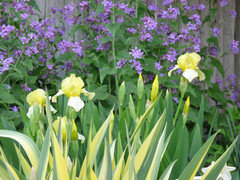
vtandrea
10 years agoMy bearded irises do best in the crappy soil on the back of my mound garden, something I learned after several years of disappointment. They can't be seen from the front, which is great since the foliage does get unsightly after they go by. I just call them my cutting garden. This year I let the reseeded tall nicotianas fill in between the irises and I can't see them at all now! But I'll soon have to pull those out and cut back the iris foliage in order to weed.
sunnyborders
10 years agoAs suggested above, I don't think bearded iris (especially tall ones) are good mixers in perennial beds.
The "iris beds" (tall bearded iris monoculture) of grand old public gardens of the past may well reflect these irises need for rather specific growing conditions (e.g. division after they've bloomed, in July).
Below tall bearded iris in a garden I installed and maintained. They're at the front (sunnier and drier). I couldn't maintain this arrangement over ten years if the beds were not large (a lot of space to work with) and if I didn't garden intensively.
June 2, 2010:
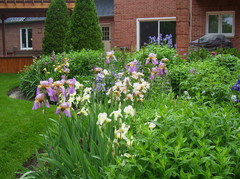
diggerdee zone 6 CT
Original Author10 years agoWell, you guys aren't helping with these photos! Maybe I shouldn't have asked for them!
I'm beginning to think that I can't truly successfully mix irises into perennial beds, but these beautiful photos are making me want even more irises!
I may have to have a few dedicated iris beds, although I don't really like beds with just one plant. But I've lost a lot of irises this year, and I'm thinking it's a combination of the amended soil, mulch (which ends up on the irises despite my attempts to not cover them) and watering.
I suppose the best way to deal with them is not necessarily in a completely separate bed, but like I mentioned before as Roxana suggested, keep them all off to one section of the bed. It's easier to not mulch, amend or water a whole section than a plant here and there mixed in. And PM2 your gorgeous photo shows that you can have a complementary plant in the background and keep the iris to the front.
I could also try using them as accents as I do the dwarfs, but I don't think this would work in my yard. The dwarfs seem much hardier and much less fussy. They grow in shade, in sun, in amended soil - I pulled up a clump last year and never got around to replanting it, and it lasted the winter laying on it's side in the vegetable garden. I only l have a small area that is hot and sunny and dry, so the tall bearded guys need to go in that area.
Thanks for you help, everyone. I think I have some rearranging to do!
Dee
mnwsgal
10 years agoI remember that gottagarden had some wonderful combinations with iris in her borders. Perhaps you can find some photos of hers by using the search function.
Thanks for asking the question. I am also interested in this subject as need to move my iris bed to make way for a new vegetable bed since the trees have grown changing the amount of sunlight and the area with the iris is the best sight for a new vegetable garden.
I have done both dedicated beds and mixing iris in the borders. The dedicated bed is planted with annuals to help cover the foliage after bloom. I have noticed that the arboretum cuts their iris foliage in their dedicated beds which are set a long ways from other garden beds. Cutting back the foliage doesn't appear to hurt the iris as they have a spectacular showing each spring.
Dividing iris in a border bed can be a pain. Trying to get them dug up without tramping on other perennials or leaving bare spots after, yuk.
My thought is to plant the iris near the front of a new bed then add daylilies close behind so the daylily foliage drapes over to cover most of the iris foliage. Not sure what to plant behind the daylilies to hide their dying foliage. Maybe mums and asters.
I have been replacing bearded iris in borders with Siberian iris that I grew from seed received from swaps. They don't need dividing as often and the foliage stays nice throughout the summer. They also have the same watering requirements as most plants, about an inch a week.
Also love the iris cristata and iris reticulata for edging and under trees. Have several very small dwarf bearded iris as well that I plant along the front of a bed making it easy to divide when needed.
aseedisapromise
10 years agoI've always had my iris in my xeriscape bed, and they go just great there. So they do look good in a perennial bed, it just has to be the right kind of perennials.
I included the AIS blog where you can find a link to an article with gottagarden's pictures. It is from June 2011 if it just takes you to the present article. Hers are more perennials that look good with the iris, blooming at the same time as they do. I mostly have the iris so there is something there in my xeri after the alliums and and before the perennials in the picture I included. I've found that it's hard to plan for things to bloom at certain times, as I've had my TB iris bloom anywhere from early May to the second week of June for the same iris in different years. The weather is so variable here. Only one year have I had iris and peonies blooming at the same time, So I just let the iris be the show, and then the other xeri perennials later.
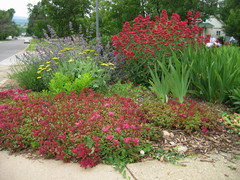
Here is a link that might be useful: AIS blog
sunnyborders
10 years agoThanks DD, but sorry my post had the opposite to the intended effect.
Still, what is it that real gardeners do?
The impossible!mad_gallica (z5 Eastern NY)
10 years agoDee, did you ever get some of my I. tectorum at a swap? It plays well with others. I have white and somebody else has blue. The Louisiana I have won't stay put. Every year it shows up in a slightly different place, and is a fairly awkward plant. It also survives perennial beds just fine.
Maybe ten years ago I moved all my TBs to a separate bed.
aachenelf z5 Mpls
10 years agoI stopped growing the tall bearded iris mainly because of the need for staking, but keep in mind you still have alternatives other than just the dwarfs. I love the dwarfs, but the intermediate bearded iris really work well for me too. They bloom after the dwarfs, but before the tall and for me at least, seem to have a longer bloom season. They're much taller than the dwarfs - 16-27 inches - but still shorter than the tall, so staking is hardy an issue.
As already stated, it think it works well to grow these on the edges of your beds - easier to divide when necessary, plus it's easier to keep the edges of your beds drier when you water. Taller perennials or annuals are planted behind mine which grow up and over the iris foliage by later in the summer when iris foliage is at its worse.
Kevin
diggerdee zone 6 CT
Original Author10 years ago" So they do look good in a perennial bed, it just has to be the right kind of perennials...."
Yes, thank you, aseedisapromise, that was exactly my question!! - "the right kind of perennials". I'm not really worried about the foliage, or cutting it back, etc., but about siting the iris with the right mix of other perennials so maintenance is easier. I will take a look at the link you provided later today, as both you and mnwsgal recommended gottagarden's ideas.
And seed, is that sedum surrounding your irises? Funny, because that's exactly what I was thinking of doing with my irises! I was thinking with some despair that that is the only plant I have that matches the iris needs!
mnwsgal, you are dead right regarding irises being a pain to divide in a perennial bed. Although, I hate moving iris to begin with. They seem so easy to dig up and replant at first glance, needing to be just on the surface, but then you realize that the rhizomes have roots that reach to China and you have to dig a big hole anyway. Maybe I'll try a few more siberians in the beds...
No, MG, I don't think I ever got any of those irises...
So, as of now this is my plan. I was planning on rearranging my sun beds anyway. I think I will either move the irises to one side of the bed, or perhaps even create one dedicated bed and look into more xeric plants. I have creeping sedum and taller sedums (actually already have some tall sedums near the irises in that one bed). This one bed is in great need of cleanup and improvement anyway, (it's overtaken with echinacea and rudbeckia reseeders!) so this is a good chance to rearrange with the irises in mind.
Gotta go get my errands done so I can spend this afternoon browsing through gottagarden's pictures! Thanks guys!
:)
Deesunnyborders
10 years agoRe other types of iris, mentioned above.
Find Siberian iris tends to coexist quite well in mixed perennial beds.
aseedisapromise
10 years agoYes, it's just a patch of Dragon's Blood with the iris. Also Centranthus ruber, Six Hills catmint, and Moonshine yarrow. All are low water perennials. The other thing you could try if you were planting them with more average water needs perennials is to plant them on a mound of soil with very good drainage. They would grow off of it, so you would have to be fussing with them, but it would keep them high and dry for a while. You would have to factor in the mound as you were thinking about height, of course. Maybe intermediates or border beardeds would do well with this treatment and not be sticking up too tall. Depends on what you were thinking of using with the iris. To be fair, here is the garden in August when the Sedum Matrona is blooming and the iris foliage isn't so nice.
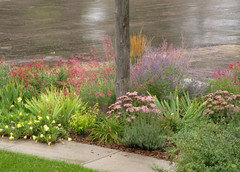
wieslaw59
10 years agoI have many Iris sibiricas. They have many shallow roots which are VERY FAR REACHING, so you cannot have weaker growing plants in the close distance from them. I have always wondered how people grow lupins and bearded iris together, as according to many books/statements , these plants have different soil pH requirements to be thriving(acid for lupins and neutral/alkaline for bearded iris).
This post was edited by wieslaw59 on Sun, Sep 1, 13 at 17:32
molie
10 years agoThanks, Dee, for asking those questions about Seed's plantings --- exactly what I wanted to ask her. I thought they were Cent. rubber and sedum. I like the bright red look of them that sets off the iris foliage (recalls a Van Gogh painting) --- and the fact that the whole area is mounded up, which is beneficial to the iris.
That's the way my mother grew them in her gardens--- right behind a fieldstone wall that my father built on the hill behind the house. It was sunny, dry and raised. Plus, because it was up on a hill, they were not as prominent behind that wall when the leaves began to get ratty in late summer. She always cut the leaves off in a fan shape --- is that something you folks do, too?
SunnyBorders, those tall, paler Bearded Iris plants are striking in front of what looks like Allium and Poleonium.
Folks, I'd love to see more of your photos. Though I think Iris are beautiful, I haven't grown many beyond what came with the house and the easy care varieties.
katob Z6ish, NE Pa
10 years agoThose are some nice iris pictures! Aseed- love that bed, I don't think the foliage in the second picture looks bad at all..... Is that just me? A few yellow tips wouldn't bother me much especially later in the season and I think the grayish upright foliage actually adds more to the bed.
I find that some iris are just better in a mixed bed than others. Most of mine are older varieties, and I save the fluffy fancy ones for a dedicated bed or put them in the veggie garden. The older ones seem to look better after bloom with neater foliage and less foliar disease.... So I guess my point is to take a look at which varieties you're growing and maybe find ones that deal with what your beds offer.... Kind of the same thing as what others who have "culled their flocks" have suggested.aseedisapromise
10 years agoThanks, kato. I think as long as you have a big sedum or something blooming at the same time, then the iris foliage is okay regardless. I did notice that a neighbor has some historic iris around her vegetable bed which of course gets a lot of water, and they do look pretty bad right now all sprawled out every which way. I'm not saying historics are bad, but that it does, as you suggest, depend on the varieties. I have a IB historic that blooms like gangbusters in full shade. The other historics next to it get about one bloomstalk each, so I am moving them now. They were there when I moved here. One could get a lot of help from folks who have iris in your similar climate on the iris forum, but it is slower there now that the main iris season is past, but it might be worth a try for dee to do it before she gets something. I would agree with wieslaw that bearded iris can be a bit overbearing. I don't have experience with sibs. I have a friend who gave me a "clump" but it looked like the worst tangled mess I ever saw, so it went to the plant swap. I didn't want that thing in my beds and I didn't want to untangle it and I didn't want to water it. I imagine where Schreiner's is in the Willamette valley, their soil is on the acid side. Judging from my attempt at lupines, if the soil isn't acid they are yellow, yellow, yellow, and Schreiner's aren't, so they must have some acidity to their soil. According to the AIS website, the best soil pH for iris is on the acid side of neutral, so lupines and iris are good companions there.
p.s. I have lots of modern, frilly iris in that xeri bed and they do fine with the slightly alkaline soil and dryness, and so the tolerance that dee and kato would need would be for tolerance to humidity and rain.

Thyme2dig NH Zone 5
10 years agoGreat thread. I've been thinking about putting my TB on warning. I moved them to the edge of a mixed border a couple years ago. This year they bloomed so well, but then flopped and then the foliage looked terrible. Glad to hear it's OK to cut some foliage because that's what I did not even bothering to ask the question. So I'm finding them to be a bit of work between staking and cutting, etc......
But then I think, there are plenty of perennials that I give a little extra time to, so why not iris? I'm just so torn as to if I like them enough to give them extra time and care. But these pics, like Dee make me want more!
Seed.....I almost gasped when I saw that centranthus. So THAT'S what it's supposed to look like! Mine is so meager and wasting away. Probably too much shade and too rich soil.
In that last photo, do you have those iris staked? Do your stand on their own?Sunny, what are the blue and purple flowers mixed in with the iris in the close-up photo? I like that combo.
PM2, beautiful spring border. Does the variegated iris foliage look junky after blooming also? I've thought about getting one and your pic has convinced me.
See! Here I am putting them on probation at the beginning of this thread, and now making a note of what iris to add to the garden. I'm hopeless!
sunnyborders
10 years agoThanks Thyme, the blue is the common (species) Jacob's ladder and the purple is a columbine (Winky mix).
The large bulk of the irises there were not variegated, so the variegated leaves were hardy noticeable. Picture below is that garden on August 14, 2010. Because of the large size of that flower bed, the large clumps of other blooming perennials take one's eye away from the generally unattractive iris leaves. I'd cut the iris back by later August.
Have a couple of variegated iris in our own garden (Iris pallida cultivars). Hardy, but not very striking (just my personal taste!). Never used to be a fan of variegated perennials. Am now, after conversation with a friend and after starting to use variegated Brunnera 'Dawson's White' and very especially after rediscovering variegated Phlox 'Nora Leigh'.

aseedisapromise
10 years agoI've never staked my iris. I've only had one stalk get broken, and that was the stalk in the very back of that last photo that is an iris that is 40+ in. tall. (approx a meter) We get some very strong winds and that did it one time. Otherwise things stand up tall and nice. One of the nice things about living in the arid west is that iris are easy.
thyme-probably the problem is more the amount of sun for your Centranthus, not the rich soil. Cent would love to populate the whole world with little seedlings, if only there was enough sun everywhere! Rich soil would just be the icing on the cake!
wieslaw59
10 years agoAseedisapromise, it the centranthus ONE plant or several planted together?? The most impressive clump I have EVER seen.
aseedisapromise
10 years agoI started with six plants, three on each side, but took one out on each side when they got so much bigger than advertised. You are looking at them with one behind the other from the angle in the first pic though. I grew them from seed I got from Stokes.
diggerdee zone 6 CT
Original Author10 years agoWow, I could never grow centranthus from seed! I tried several times and finally gave in and bought some from Bluestone. Mine aren't anywhere near as big as yours though!
Dee
Thyme2dig NH Zone 5
10 years agoOk, so now I'm jealous you never stake. I'll move my centranthus to my front slope which is very sunny....if I can even find it at this point! It will be allowed to seed with reckless abandon there. When you started from seed, did you WS, start inside or DS?
Yes, now I can make out that it's Jacobs ladder and columbine. I really like that combo mixed in with the iris.sunnyborders
10 years agoSorry Thyme.
I think the purple flower you was noting was Allium, as was suggested ('Purple Sensation').Have Centranthus ruber in one sunny location. Deadhead it, so only get minimal seeding.
As noted above, I've also found that old No Name tall bearded irises have greater longevity than some of the newer cultivars. Guessing they're the ones that have been tough enough to survive over time.
I usually need to stake the flower spikes of tall irises.
sunnyborders
10 years agoSorry, repeat.
This post was edited by SunnyBorders on Wed, Sep 4, 13 at 15:39
aseedisapromise
10 years agoI started those plants inside. At the time I didn't know anything about WS. I think this was back about 2004 at my old house across town. I did try to WS some last year here at my new house, and but the seed is so old by now I only got one sprout and it didn't get past the soggy spring weather we had last year. I have some new seed for this winter, and maybe I'll try some indoors too. It's funny because the reseeding was so bad that I would go out twice a year with a trowel to knock down all the babies. So maybe I should try DS as well. Maybe I should be thinking about that right now!
nutmeg4061
10 years agoI found some GORGEOUS pic threads from the Iris Forum.
Here is a link that might be useful: Iris and their companions
moliep
10 years agoNutmeg, that was a very evil thing you did there! You added "fuel to the fire of my growing desire" --- a little alliteration to make me laugh at myself.
No, I won't do it! I thought I had turned the corner on Iris Lust, especially for the bearded types --- had given them up as impossible in my yard.
Looking at the beautiful photos and combinations in this thread, I had started to feel the old pull return. These iris made bold, regal statements in the gardens. Plus I even enjoy the look of the variegated yellow or white leaves of some iris. Aseedisapromise, SunnyBorders, and PM2 started me imagining that I could combine iris with the perennials already in my garden.
Then I saw gotta garden's pictures --- from western NY AND in a colder zone! :(
mad_gallica (z5 Eastern NY)
10 years agosomething to keep in mind with bearded iris...
Cold isn't generally an issue. There are some that do have problems with zone 5, but they are reasonably rare. What does bother them is wet. So instead of getting harder to grow the further north you go, they get harder the further east.
aseedisapromise
10 years agoYes, do listen to madgallica, it is the wet that is the problem. I am not sure what gottagarden does to get things to work in her climate, but she must know some tricks. One you can tell just from her photos is to have her plants with salvias, catmints, and other plants that don't take so much watering. Another is to have iris such as Lady Friend, which is a pretty accommodating iris. Some of the other iris I am not as familiar with, but there are some that just grow like crazy and are just sturdier in general. Maybe one is to take the good photos in the good year when they had a drought there and the iris looked especially good. You never know just looking at photos people post of things, they are always when the plant is at its best. You have to look at the plant during its whole lifetime, good years and bad. Maybe a thread on iris that do well in the wetter eastern climate, or tricks for getting good results with iris in a wetter climate would be a good idea for the iris forum now before deciding on whether to keep them or replace them in your own garden.
sunnyborders
10 years agoThe links certainly are useful, Nutmeg.
Thanks."You never know just looking at photos people post of things, they are always when the plant is at it's best. ---".
Frequently true, Aseedsisapromise and it does make me feel a bit uncomfortable.Of course, garden magazines sell themselves and other commercial interests, doing this, all the time. In that case, the part that irritates me, is being told by a non-gardening journalist how to succeed in gardening.
Most perennials here bloom for two or three weeks per year. It is informative to see the possibilities at different times in their life cycle and at different times during the growing season (as you also say).
On the other hand, I'm not so sure there'd be very general interest for pictures in these cases, except for specific problems (e.g. iris borer).
I do think it informative for members to post views of whole/parts of perennial beds and not just pictures of individual plants. Even selecting the views to show still gives something of what's working in a perennial bed, when, and maybe also what could be better.
diggerdee zone 6 CT
Original Author10 years agoWell, that's it. Stick a fork in me, I'm done. I looked at gottagarden's photos and now I gotta have more irises!
But I will restrain myself! I'm going to do some rearranging, and some research on companion plants over the winter, and take it from there.
Just wanted to say that I've really enjoyed the conversation in this thread, and appreciated everyone's input. Thank you!
Dee
My own poor contribution - Fair Dinkum

david883
10 years agoDee - love those blue ones! Your thread inspired to integrate more irises (good thing I have seeds on the way).
PM2 - those yellow irises with the lunaria are BEAUTIFUL! I have a purple/yellow bed I'm planning and I already have lunaria going in there... Don't be surprised if I post pics next year with some yellow irises to accent them :)
aseedisapromise
10 years agoI love blue iris also, and yours are indeed "fair". I especially like how they look in bud, at least the varieties that I have, and yours looks like it is no exception. Good luck with iris, all!
moliep
10 years agoThanks, everyone, for your photos of inspiration and for the tips. Here along the river, flooding is sometimes a problem as well as seasonal dampness.
I did follow the suggestion to check the iris forum for varieties that would grow well in my situation. Found a thread headed "rebloomers more prone to rot?"
Read all the way to the end of this thread to the last entry where Iris_gal posted a copy of an article titled "Sand and Soap."
This really had me thinking about planting iris in my yard. Has anyone used these techniques?
Molie
Here is a link that might be useful: Rebloomers more prone to rot?
aseedisapromise
10 years agoIn my area, the sand would all blow away during an open winter. I had that happen at my new house with its sandy soil, and the iris I had moved from my old house either died of dryness, or looked sort of like walking catepillars or rhizomes on stilts if they were able to get some roots down. But it could work in a sheltered place. Experimenting is good.
prairiemoon2 z6b MA
10 years agothyme2dig, yes, the variegated Iris foliage does get a little junky but maybe it's just me, but I don't think it's as noticeable. I've cut mine back about 3 weeks ago. Still, it does come back clean and fresh every spring.
david883, It is a pretty combo, I just wanted to point out to you, that there are two different Iris in that photo. There is a variegated Iris in the front, that is not blooming yet, and behind it is a plain yellow Iris. The variegated blooms a purple flower that smells like grapes, after the yellow Iris. Look forward to your spring photos. :-)
Aseedisapromise, love your color combinations.
Dee, great blue Iris.
katob Z6ish, NE Pa
10 years agoBeautiful iris pictures, I really love the fancy ones..... Reminds me of another post about plants you've loved and then left and then returned to. I can feel an iris addiction coming on :)
ASeedisapromise- I remember my first Iris order from a western grower. I never knew the rhizomes could even get that big! Trust me they got smaller fast enough once they were planted in my garden!
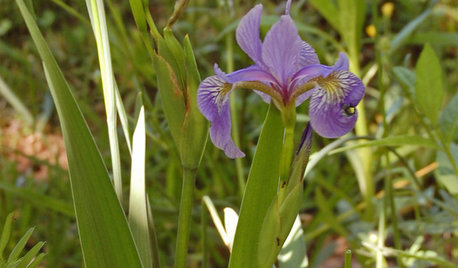
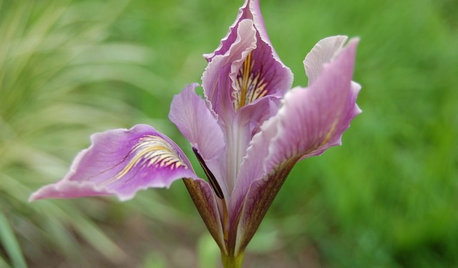
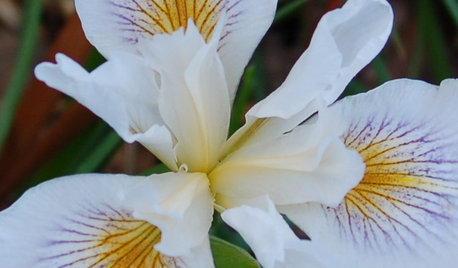
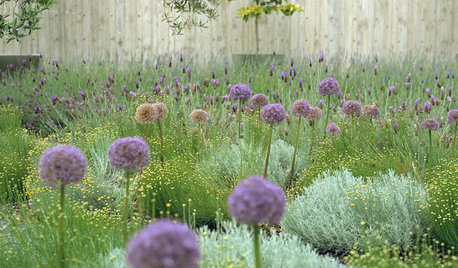
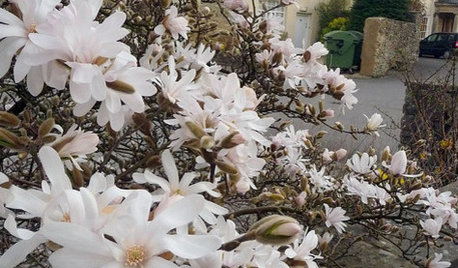
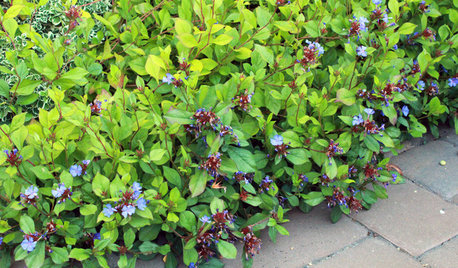
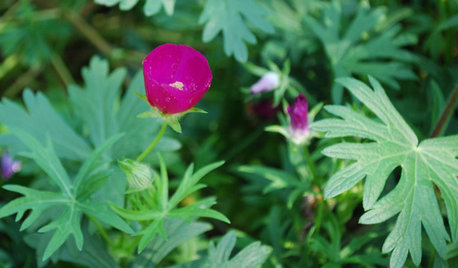
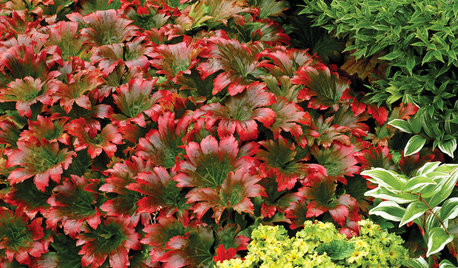
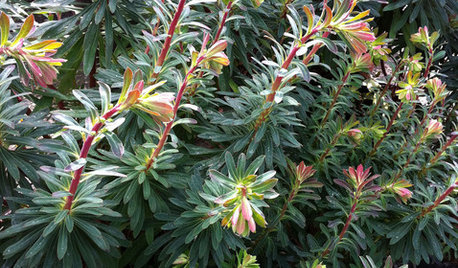
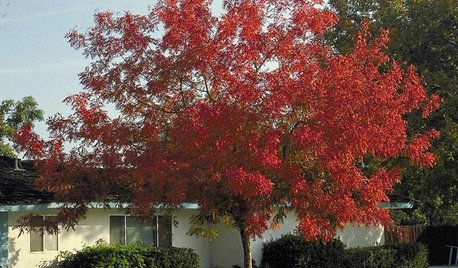






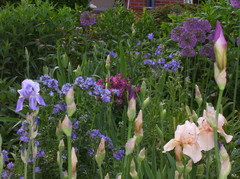
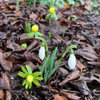

prairiemoon2 z6b MA